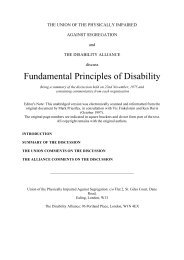Global-Report-Living-Colour-dr2-2
Global-Report-Living-Colour-dr2-2
Global-Report-Living-Colour-dr2-2
You also want an ePaper? Increase the reach of your titles
YUMPU automatically turns print PDFs into web optimized ePapers that Google loves.
Inclusive Communities = Stronger Communities<br />
GLOBAL REPORT ON ARTICLE 19: THE RIGHT TO LIVE AND BE INCLUDED IN THE COMMUNITY<br />
111<br />
‰ Deinstitutionalization is more than closure<br />
Perhaps the first and most important lesson learned is<br />
that deinstitutionalization is not just about closing<br />
institutions – not just about the evacuation of people<br />
from one environment to another. We have learned<br />
that deinstitutionalization involves assisting people to<br />
leave institutions and take their rightful place in<br />
community and also that it involves the development<br />
and provision of appropriate and adequate<br />
community and family based supports and services<br />
for both those leaving the facility as well as for those<br />
persons who are currently living in community. We<br />
have learned from past efforts that<br />
deinstitutionalization must be as much about<br />
supporting people to continue to live in the<br />
community (e.g. prevention) as it is about closing<br />
facilities. To do otherwise simply means that over<br />
time persons leaving the facility will be replaced by<br />
others from the community who cannot access<br />
needed supports to continue to live in community.<br />
AUSTRALIA Not explicitly, but<br />
through funding people are hindered<br />
from living in the community.<br />
JAPAN There have been initiatives<br />
in Japan, but at the same time we<br />
have the fact that the number of<br />
institutions is growing. From the<br />
research only 3.4% has been<br />
deinstitutionalized and two of the<br />
main new placements are their homes<br />
and group homes. We have to add<br />
another fact that almost the same<br />
number of people are newly<br />
institutionalized.<br />
‰ Everyone can live and be included in the<br />
community<br />
Another major lesson learned is that all people living<br />
in institutions can live more successful and inclusive<br />
lives in community. We have learned that community<br />
living is for all people – not just those who have less<br />
significant challenges. Experience in countries such as<br />
the UK, Canada, USA, New Zealand, Norway and<br />
Sweden have demonstrated beyond doubt or debate<br />
that institutions do not need to exist (or continue to<br />
exist) to serve the needs of certain groups of people.<br />
Research from numerous institutional closures have<br />
unequivocally demonstrated that persons with<br />
“severe” disabilities, those with challenging behaviors,<br />
people who are “medically fragile”, and persons of<br />
advanced age (who have lived in the institution for<br />
many years) can all be successfully supported in<br />
community.<br />
LESOTHO “We believe that people with<br />
disabilities should not be kept in<br />
institutions, since it’s like treating them<br />
like animals, where their minds are<br />
restricted. They have the right to be part<br />
of their families and siblings. Families<br />
and communities should learn how to<br />
take care of them”



